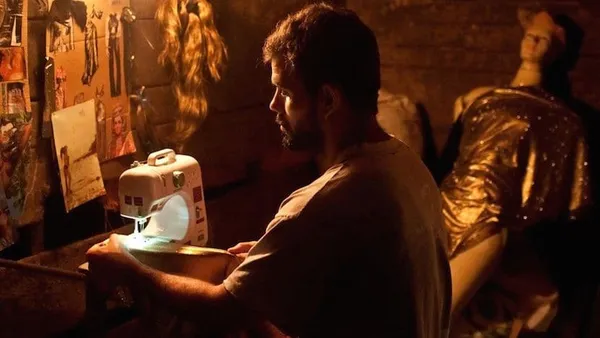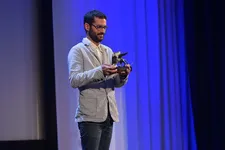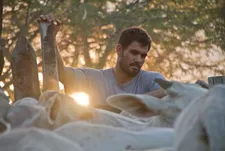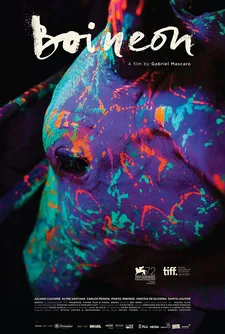 |
| 'I didn't want to subvert the gender roles or invert them but to dilate them' |
Mascaro - who won a Special Jury Prize for the film at Venice Film Festival - says the contradictions in the action reflect the landscape of north-eastern Brazil where the film is set.
Speaking to me ahead of the film's screenings at London Film Festival, he said: "In some way, the film is all located in a place that's undergoing a process of transformation and change. So in the same way that the landscape is in a process of transformation, the relationships between the characters are also going through a process of transformation to deal with this new context.
 |
| Gabriel Mascaro picks up the Orizzonti Special Jury Prize for Neon Bull at Venice Film Festival Photo: Courtesy of Venice Film Festival |
The themes of transition run deep, not least between the expectations of the audience in certain scenes and the way that Mascaro subverts them, particularly regarding sex. An early scene in which Iremar and his rodeo colleague Galega (Maeve Jinkings) are in tight confines looks ripe for carnality but, in fact, he is merely measuring her up for his latest fashion creation. Things not immediately associated with eroticism - such as a man on horseback - take on a sexual charge, while traditional gender roles are also fluid, with Iremar seen as more nurturing than Galega.
 |
| Juliano Cazarré as Iremar in Neon Bull. 'The link with the real world was present the whole time' |
"So, depending on the distance, you can reinforce stereotypes or not. When you get too close to the characters, you reinforce stereotypes, but when you distance yourself more, it allows the stereotypes to become more diluted and to break down the viewer's stereotype. When I move the camera away, it gives more to the characters.
"Whether I was shooting an animal or a human body, I treated it in the same way. That doesn't mean to humanise animals or make human bodies more animal but I wanted to make them more equal, so that you regard them in the same way."
Its almost impossible not to draw parallels between the division of the sexes and the horses and bulls that are ever-present through the film, with the horses like the 'supermodels' of the piece - to such an extent that, in one scene, we see one getting a makeover fit for Katie Price or Kim Kardashian - while the bulls are more workmanlike. In one scene a horse we have just witnessed being dolled up is paraded round the auction ring under the name Lady Di. Later, backstage, Iremar and his friend try to pinch some of the high-priced horse semen with Mascaro working the scene for both tension and humour.
 |
| Gabriel Mascaro: 'In some moments, I blend the film with some naturalistic experiences with much more surrealistic elements' |
"In some moments, I blend the film with some naturalistic experiences with much more surrealistic elements. This creates some kind of humour but the surrealistic elements are part of the contradictions that this world is bringing to the characters. This surrealism that brings the humour reflects on the contradictions that exist with the rapid development that has come to the region. The horse with a hairstyle and a lot of jewellery... it's a commentary on what's happening in the region and how it is surreal.
"The idea is for the spectator to always have an ambiguity and that there could be two readings. I always work with the aim of creating an expectation for the spectator and then kind of subtly break that down so they can see new ways of viewing that scene or that situation. For example, when Junior - a cowboy who comes in at the end - is straightening his hair as the others have breakfast. The audience immediately laughs when they see that scene because it's amusing. But I chose to let that scene carry on for several minutes, to see the construction of the interaction between the different characters and that enables that not just to be a funny scene about a guy straightening his hair but it takes the idea away from him and towards the other characters to see how they relate to that situation."
 |
| Neon Bull poster |
"It was quite intense," he said. "The other two characters, the guy with the big belly, Zé, and the second cowboy who doesn't say much, they do work in vaquejada rodeos. Juliano lived sharing a room with them for this time during the preparation. So he really observed and absorbed everything they were saying. The would discuss things and stay up late and night. He studied the way they speak. So as an actor he drew on them, and they had experiences in real life vaquejadas so he understood how it all worked. The link with the real world was present the whole time."
Neon Bull will screen at Chicago International Film Festival on October 19, 24 and 25. For more information about the film, visit the Facebook page.





















